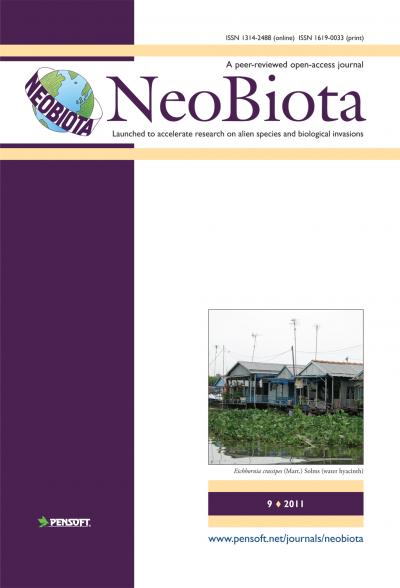Potential impacts of invasive crayfish on native benthic fish: shelter use and agonistic behaviour
IF 3
2区 环境科学与生态学
Q1 BIODIVERSITY CONSERVATION
引用次数: 0
Abstract
Spinycheek crayfish (Faxonius limosus) and signal crayfish (Pacifastacus leniusculus) are successful North American invasive crayfish species distributed throughout Europe. Both species compete with native benthic fish for shelter. In a laboratory approach, we assessed competition for shelter and antagonistic interactions between these invasive crayfish species and the native benthic fish species, stone loach (Barbatula barbatula) and bullhead (Cottus gobio). This allows for studying the potential impacts of invasive crayfish on native benthic fish. Spinycheek crayfish and signal crayfish were able to gain control of the shelter and could successfully displace both benthic fish species. For stone loach, the presence of crayfish significantly decreased their shelter use and caused several behavioural changes such as reduced activity and increased hiding behaviour outside the shelter. Although the shelter use by bullheads was not reduced, they displayed similar behavioural changes, if less intense. Invasive crayfish species showed remarkable combative interactions against both species of benthic fishes, evidenced by the high number of aggressive interactions, especially concerning stone loach. Our results highlight the pronounced dominance of invasive crayfish over benthic fish in terms of shelter competition and aggressive interactions under laboratory conditions, which consequently might promote the latter’s exposure to predation.Potential入侵小龙虾对本地底栖鱼类的影响:庇护利用和对抗行为
棘周小龙虾(Faxonius limosus)和信号小龙虾(Pacifastacus leniusculus)是分布在整个欧洲的成功的北美入侵小龙虾物种。这两个物种都与本地底栖鱼类争夺庇护。在实验室方法中,我们评估了这些入侵小龙虾物种与本地底栖鱼类物种石泥鳅(Barbatula Barbatula)和牛头鱼(Cottus gobio)之间的庇护所竞争和对抗性相互作用。这有助于研究入侵小龙虾对本地底栖鱼类的潜在影响。棘周小龙虾和信号小龙虾能够控制庇护所,并能够成功地取代这两种底栖鱼类。对于石泥鳅来说,小龙虾的存在显著减少了它们的庇护所使用,并导致了一些行为变化,如活动减少和庇护所外隐藏行为增加。尽管牛头人使用庇护所的情况没有减少,但他们表现出了类似的行为变化,尽管强度较小。入侵小龙虾物种对这两种底栖鱼类表现出显著的对抗性相互作用,大量的攻击性相互作用证明了这一点,尤其是对石泥鳅。我们的研究结果强调,在实验室条件下,入侵性小龙虾在庇护所竞争和攻击性相互作用方面明显优于底栖性鱼类,因此可能会促进后者受到捕食。
本文章由计算机程序翻译,如有差异,请以英文原文为准。
求助全文
约1分钟内获得全文
求助全文
来源期刊

Neobiota
Agricultural and Biological Sciences-Ecology, Evolution, Behavior and Systematics
CiteScore
8.10
自引率
7.80%
发文量
0
审稿时长
6 weeks
期刊介绍:
NeoBiota is a peer-reviewed, open-access, rapid online journal launched to accelerate research on alien species and biological invasions: aquatic and terrestrial, animals, plants, fungi and micro-organisms.
The journal NeoBiota is a continuation of the former NEOBIOTA publication series; for volumes 1-8 see http://www.oekosys.tu-berlin.de/menue/neobiota
All articles are published immediately upon editorial approval. All published papers can be freely copied, downloaded, printed and distributed at no charge for the reader. Authors are thus encouraged to post the pdf files of published papers on their homepages or elsewhere to expedite distribution. There is no charge for color.
 求助内容:
求助内容: 应助结果提醒方式:
应助结果提醒方式:


